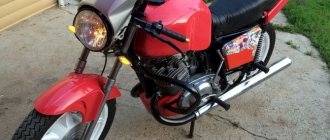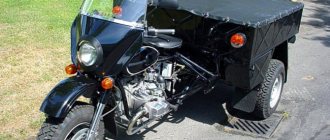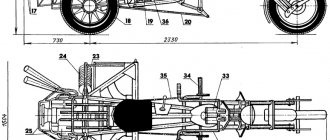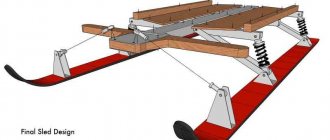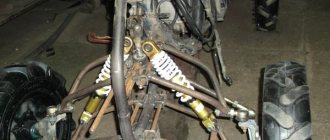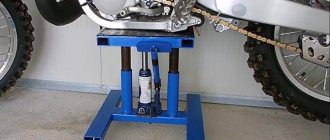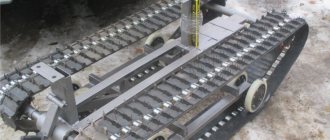A motorcycle exhaust is a complex design. The more modern the model, the more intricate it is. Moreover, the operation of most options is directly related to electricity. For example, if you remove the chip, the “iron horse” may not start at all, but simply blink a light. We will focus on how a motorcycle muffler works, its operating principle and parameters. Thanks to this information, you can quickly figure out the cause of the breakdown, a change in the sound of the running engine.
Modern motorcycle models are equipped with sound-absorbing or resonator mufflers. In rare cases you can find a combined system. Most often, resonator mufflers are installed. However, lovers of rumbling sound prefer sound-absorbing types made of stainless steel or aluminum. They are also distinguished by their aesthetic appearance and improve “breathing”. Models made from other materials are more expensive.
Titanium mufflers have proven themselves to be particularly durable. That's why they are chosen by lovers of active driving. Installation of this type helps to minimize the possibility of damage to the muffler when colliding with an asphalt surface.
Purpose and principle of operation of mufflers
Despite its apparent simplicity, the exhaust pipe solves a number of important problems. Among them:
- suppression of sound vibrations that occur during combustion of the fuel-air mixture;
- reducing the degree of heating of gases with critically high thermal parameters;
- reduction of exhaust toxicity.
Progressive exhaust systems are capable of removing exhaust gases from the power plant, as well as converting them. For smooth operation, the unit is equipped with the following elements:
- corrugated pipes that connect to the exhaust manifold. The part does not have a rigid structure and is intended to suppress vibrations;
- a catalyst that ensures the deactivation of components harmful from an environmental and hygienic point of view that appear when hydrocarbons burn out;
- a resonator made in the form of a small expansion, which stops the movement of gases through the pipes. The standard element only suppresses exhaust system pulsations, but does not reduce the noise level. Therefore, it is equipped with auxiliary components;
- muffler, where the exhaust cools and loses its initial velocity by dissipation.
The design is complex and is intended to distribute the flow of gases and suppress vibrations caused by the operation of the system.
The performance of all components of the exhaust system is determined not only by design features, but also by the mass of the products. If heavy metal is used, the operation of the equipment will be quieter, since such materials are less susceptible to vibrations.
Light alloy products with thin walls not only wear out quickly, but are also vulnerable to rattling. Therefore, they themselves produce unwanted noise.
How does the exhaust work?
The main responsibility is to ensure that the air is vented and cooled so that the reflected gas flows back to the outlet before it opens. However, some people forget about this, focusing only on sound quality. So, the muffler also:
Ideally the exhaust works like this:
To cool gases efficiently and quickly, they must expand . To do this, the volume of the exhaust system must be significantly larger than the volume of the cylinder.
According to the rules, the length of the intake tract is designed so that the reflected gas flows back directly to the valve opening. In this case, the filling of the cylinder becomes greater, which increases the power of the motorcycle. The reflected waves, returning to the new outlet, help remove the exhaust gas.
If the gas returns to the valve while it is still closed, then when it opens it will direct some of the waves back.
Extinguishing the flame, cooling the gases and venting them to the rear of the motorcycle
This is the second most important function of the exhaust, protecting primarily the driver, and not the device itself. It is strictly not recommended to start a motorcycle without a muffler, because flames fly out of the pipe, which can cause irreparable harm.
Hot gas must be cooled - this is what pipes do . To prevent smoke and hot air from causing inconvenience to the driver, the pipe is routed to the rear of the vehicle. The most optimal exhaust location is when the pipes are not directed towards sensitive parts of the motorcycle. Some people forget about this, which causes panniers or other plastic parts to become scorched.
Environmental friendliness
Currently, much attention is paid to ecology. Therefore, modern models are equipped with complex exhaust systems with catalysts and filters.
Noise reduction
This is not such an important option, but you can’t do without it. When the exhaust is properly tuned, the motorcycle produces that velvety “purr” that pilots love so much. However, sound is not a design goal, but only an accompanying characteristic.
No one likes a high, rough exhaust tone - a lower timbre is much more pleasant to the ear. For this reason, many drivers chase beautiful rumbling sounds, and after installing such an exhaust they find out that they have additionally increased the power of their iron horse. A well-tuned and functioning exhaust can improve the performance of a motorcycle.
DIY sandblasting cameras 6 photos
A sandblasting chamber is a useful thing in the house. Do you need to clean some coating, remove metal corrosion, or remove contamination? No problem. The cleaning process occurs by spraying an abrasive material under pressure inside a closed space. In self-built sandblasting chambers, you can use the following as an abrasive:
- Quartz sand of different fractions.
- Cast iron or steel shot.
- Slag remaining after processing copper and nickel.
The chamber can be built from a regular OSB sheet. You can buy it at any lumber market. The camera can be any size, you need to choose it for yourself and understand what it will be used for.
Detailed operating principle. Only the size and body of the structure can differ.
Such chambers are called habitable because the part is processed directly by a person. Wearing safety glasses is recommended. Thick rubber gloves are attached to the holes. It is prohibited to climb into a working chamber with bare hands!
It was made to be portable. Total weight – 10 kg. The base is made of iron profiles and aluminum sheet.
Transparent storage container. Volume – 30 liters. You can buy it at a building materials store.
According to the author, it was made by eye from what was in the garage. I just wasted my time. Intended for cleaning car rims.
Read in full (link)
DIY straight-through muffler
Today, a large number of additional accessories have been developed for motorcycles that serve various purposes. Direct flows are suitable for bikers who love to hear the sound of a roaring engine. They are produced by various companies. Thanks to this, everyone has the opportunity to choose the most optimal option for themselves. However, there are motorcyclists who have a limited budget, but for them, re-equipping and equipping a bike with everything necessary is not a difficult task. After all, they can do everything they need on their own.
It is best to make a do-it-yourself forward flow onto a motorcycle from a high-quality steel tube of the optimal size. It can have different shapes and lengths. The main thing for its fire resistance is to cover the surface with a protective layer.
For the tube, you need to assemble two end caps and make holes in them. All work is carried out using a welding machine.
Assembling a muffler with your own hands is not difficult. The main thing is to have welding skills in order to assemble all the parts together. If you do everything correctly and carefully, you can assemble a muffler similar in quality to those sold in motorcycle dealerships.
Making a direct-flow muffler from scratch
You can make such a muffler from scratch. This will be a completely new version made from several components. The difficulty of this operation, called tuning from scratch, lies in finding the diagram of the exhaust system of a particular moped.
Tools and materials
In this case, again, you need to prepare the necessary tools and materials.
- Purchase in a store or find two pipes with a diameter of 33 mm;
- Buy plexiglass;
- Bolts M8 and M3;
- Prepare glue and nails;
- Welding machine;
- Needles;
- Hacksaw for metal.
Let's start assembling
First of all, you need to cut 18 cm from one of the pipes. It is recommended to carefully process the place in the cut with a needle file. From the second pipe we cut a circle with a diameter of 1.5 cm. We process it using the method described above. Glue the cut out circle in the section of the first pipe. We cut off another piece of pipe, 18 cm long. We make many holes in it. This can also be done with a sharp nail.
We connect all the parts using a welding machine. We fill the cavity formed at the junction of two pieces of pipe with mineral wool. We wrap the finished product with a special fire-resistant material. The homemade muffler is ready. To install it, you will need to attach the element to the scooter body mount.
Making a muffler mounting element
From plexiglass, which is indispensable in this matter due to its strength and easy paintability, we cut out a special type of ring, the edges of which can be bent outward by 180 degrees. We attach the resulting circles with serifs to the moped using the required bolts. We polish the muffler using sandpaper. To be sure, the joints between the homemade product and the moped body will need to be lubricated.
Homemade muffler for moped disassembled
If homemade production causes certain difficulties, you can find a lot of models of mufflers already in finished form. They are usually inexpensive. On the other hand, only a homemade version can provide the ideally expected option.
DIY flute for direct flow
If you have the desire and skill, then making a flute with your own hands in order to muffle the forward flow is not at all difficult. It will turn out cheaper than the branded one, but not always better than the Chinese one.
To work, you will need a 20 mm steel (preferably stainless) pipe and a piece of sheet metal 0.8–1.2 mm thick. It is advisable to cook using arc welding, following the rules for working with stainless steel. A pre-bent steel sheet plug with holes for fastening is welded to the pipe. You can screw it with three M8 bolts, but for installation in a few minutes, one threaded connection is enough.
During manufacturing, you should try to carefully measure the internal diameter of the muffler at the air end so that the plug fits in loosely, but without a gap. Then, when heading out to the track, you can quickly remove the flute from the hot pipe with a pair of wrenches or pliers.
Conclusion
Well, that's all, I tried to tell you about all the improvements. The story stretched over 3 articles, although there seemed to be few improvements themselves. Overall, in my opinion, the motorcycle turned out to be quite good, although it is very difficult to move off-road without toothy tires, so installing it is a top priority. If you have any questions, ask in the comments.
Fuel filter is an important addition
Source of the article: https://offroadrest.ru/ural-enduro3/
Types of mufflers
Many people associate the roar of sports motorcycles with a muffler. And they believe that filling the muffler can reduce the power of the car. But that's not true. When replacing or modifying a muffler, only a small amount of horsepower is lost.
There is an intake and exhaust silencer. And scientific research has proven that if you choose the right basic elements, you can improve the filling of the cylinder. Such mufflers are called resonant mufflers.
Noise suppression is carried out by the part of the muffler located behind the first partition, and it consists of an acoustic filter. These filters on sports motorcycles are made simpler, since a higher noise level is allowed in sports motorcycles.
When deciding to remake a muffler, you need to remember the following. Sometimes, when improving one part, you have to sacrifice the quality of another. No one has yet succeeded in creating a universal motorcycle.
Manufacturers recommend using factory mufflers for your motorcycle. The muffler cavity becomes covered with carbon deposits, which can close the acoustic filter channels. Therefore, the cavity of the device must be cleaned regularly. The resulting carbon deposits prevent the exhaust gases from escaping, and engine power is reduced. After every five to ten thousand kilometers, mufflers need to be cleaned.
The original mufflers are quite quiet and good. Their disadvantage can be considered their heavy weight and size. Many consider their high price to be a disadvantage. Silencers are produced by many companies, and you can use a non-original muffler if you wish. Most often these are open mufflers. In them, exhaust gases exit the engine without any obstacles. But they make a lot of noise.
Those who love the loud roar of motorcycles can buy the cheapest muffler, which does not muffle anything. But if the roar of the motorcycle does not suit you, then you will have to buy an expensive option.
These mufflers differ in design and material of manufacture. There are four types:
- Titanium. He is considered the best. It's light, looks nice, and doesn't get too hot.
- Aluminum. Light enough. It looks worse than titanium, but there is a drawback. You can get seriously burned.
- Carbon. Looks nice, light and cool. But its significant drawback is that even with vibrations it can crumble.
- Stainless steel. Strong and heavy, but very hot.
Each type of muffler has its own advantages and disadvantages. Therefore, you need to choose for yourself.
Noise reduction
And only at the very end of this list will there be a beautiful exhaust sound. I don’t argue that it’s the velvety peals that make you look for the source of the sound in traffic, but the pleasant timbre to the ear is more an additional accompanying characteristic at the time of development than the goal itself.
The high-pitched exhaust tones make pedestrians wince. These motorcycles are said to scream or squeal. This is because the high ranges are not as pleasant as the lower whoops. Therefore, a huge number of pilots are primarily chasing the beautiful rumbling sound of the exhaust, and only then are they surprised to learn that their new product increases engine power.
The exhaust system is often referred to as the way a motorcycle breathes. When the system is faulty, dirty or incorrectly selected, the motorcycle will suffer on the exhaust stroke, possibly starting to choke. But a well-tuned exhaust can improve the performance of your motorcycle.
Source
Cleaning the muffler
The cleanliness of the muffler affects the power of the moped
Before you start changing anything in the exhaust system, I would like to give one piece of advice. The power of the scooter is directly affected by the cleanliness of the muffler. If it were possible to see the exhaust in a cross-section of the muffler, the owner of the scooter would be very surprised. After a certain mileage, the scooter's dynamics decrease, and owners begin to look for the reasons for this, finding them in a complete rework of the standard muffler or its replacement.
The reason for the loss of power, meanwhile, may be hidden in the condition of the engine itself. This will help determine the specialist you should contact before tuning. But the most common cause of loss of dynamics is soot that clogs the muffler. In this case, it is recommended to carry out cleaning in three ways.
First method: mechanical
It involves cleaning the muffler section (it is done with a grinder). The inside of the muffler is cleaned of soot using a wire or cable. The section in the section is closed by welding.
Second method: chemical
It involves pouring water with some kind of cleaner into the muffler. For example, caustic soda is suitable for this purpose. This cleaning has the advantage that the appearance of the muffler will not be affected in any way.
Third method: heat treatment
The muffler is heated either on the scooter with a blowtorch, or dismantled in an oven or on a grill. It will be necessary to repaint the muffler only after it has cooled.
Forward flow on a motorcycle
Not all people like the noise that direct-flow mufflers make while driving on the roads. They do not allow people in residential buildings to sleep peacefully; the noise of the mufflers has a frightening effect on children.
Some motorcyclists who oppose the use of mufflers on motorcycles argue that they prefer a quieter ride that does not cause inconvenience to others.
However, those who use forward flow on a motorcycle say that this part is necessary to ensure safety.
Direct flows help in the following situations:
when it is necessary to signal your presence to drivers on the road
Everyone knows that not all car drivers like motorcyclists.
They try to harass them and not pay attention to the fact that a biker is riding next to them. This leads to the fact that if you do not signal your presence to the car driver while driving on the road, he will not notice you
When the use of sound signals and other things is not enough, the input can enter a forward flow. It makes a roar, which makes it possible to move along the highway without unnecessary trouble.
when you want to equip your motorcycle with an attractive attribute to change its external qualities.
Almost every motorcyclist has moments when he wants to change something. It can be installed for safety and as a decorative element of the arc on a motorcycle; when it is already there, you can try to make a forward flow. It will give you the opportunity to experience the new capabilities of any motorcycle device.
Motorcycle exhaust system - what is its main purpose?
The exhaust system is one of the most underrated parts of a motorcycle among ordinary people. The most common misconception is that the exhaust is only a sound. Like, I’ll replace the jar, change the sound and ok. In fact, the exhaust system is of great importance for the efficient operation of the engine. That is why it should be given a lot of attention.
I won’t tire of repeating that there are no incompetent elements in a motorcycle, unless it’s a sticker on the gum tank that you didn’t know where to put, and then it can cover up the first scratch to the metal. So the exhaust system is a precisely calibrated piece of engineering.
DIY straight-through muffler
You can buy a direct-flow muffler in any specialized stores. They are usually of interest to young motorcyclists who dream of high speeds. But real bikers are not sold on stickers from famous brands. They do everything they need with their own hands.
If you want to enter the world for real men, you need to make a direct-flow muffler with your own hands. When riding at normal speed, its noise will not be different from other motorcycles. But as the speed increases, the characteristic rumble of the engine appears. What needs to be done for this?
- Take a piece of pipe that has a diameter of 60 mm and cut it in half. First, one part is processed and a flange is welded in the middle. The outer part does not change. This is the inlet pipe. In half of the pipe, which is located in the muffler, you need to drill a large number of holes using an electric drill. You need to use a 5-6 mm drill. Recess the flange with a ten-millimeter tip into a pipe with a diameter of 100 mm and weld it.
- We are preparing the second pipe. Weld a flange to the second section of pipe. It should be 80 mm from the edge. This part of the pipe will be inserted into the muffler.
- Carefully lay mineral wool insulation into a pipe with a diameter of 100 mm. This is to combat noise reduction. To do this, roll the cotton wool along the diameter of the pipe and push it to the opposite side.
- Roll up the mesh and lower it inside the insulation that was inserted into the pipe. The mesh should fit onto the pipe with holes.
- Now you need to insert the flange with the pipe, which you prepared in advance, into the pipe with the short end. It needs to be recessed to a depth of 10 mm and welded.
- You can cut off the fastening elements from the old muffler and transfer them to the direct-flow muffler by welding them.
Protection
We won’t dwell on plastic hand protection; You can buy it in any place where Ural spare parts are sold. Let’s take a closer look at the peculiar safety arc. In general, roll bars on a Ural motorcycle are not particularly needed when driving off-road, but it’s still better with them.
Safety bars in the Urals
This arch was made from a metal bed frame, to which 4 bolts were welded for fastening to the frame. The arc performs the following functions: - makes the fall softer (although it may bend); - protects against tall grass and bushes that it crushes under itself; - can be used to install additional headlights (although they should be installed higher); - serves as an excellent support for mounting the motorcycle near a tree or on a homemade side stand. By the way, the homemade side stand is a durable bent Z-shaped tube.
Why do motorcyclists need forward flow on a motorcycle?
The exhaust system is designed to perform several tasks. Exhaust gases are removed. The exhaust gases better fill the engine cylinders. And dampens the noise. The spent mixture leaves the cylinders at a very high speed and therefore creates a loud noise. It is the muffler that reduces the noise of exhaust gases due to the obstacles installed in it.
A direct-flow muffler or direct-flow muffler on a motorcycle produces a peculiar engine roar and is not accepted by many people. It is believed that motorcycles with such a muffler disturb people and pollute the atmosphere.
Motorcyclists who promote quiet riding in the city do not accept straight-through mufflers. But experienced bikers are sure that forward flow is not only passive safety, but even active safety on the roads. How? The fact that you can indicate your location in the traffic.
Sometimes it is difficult to show some drivers even with a signal or headlights that you are nearby. And only the roar of the muffler helps to do this. And it happens that the sound of the muffler stops the driver from a careless maneuver that could lead to an accident.
How to make a muffler for a motorcycle is a question asked by many owners of motorcycles, especially domestic ones, whose appearance of standard factory mufflers leaves much to be desired. The need to make a homemade muffler may even arise among owners of imported motorcycles, for example, when tuning them (customizing). You can, of course, pay a certain amount of money and buy ready-made mufflers from some company, but often they are not suitable for some models of bikes and their mountings have to be redone. Yes, and they cost a lot. In this article we will look at how to make mufflers for a motorcycle with your own hands, on a minimal budget, and what you will need for this. In general, in one article it is simply not possible to describe the manufacture of mufflers for all types and models of motorcycles, because all bikes are different, the mounting points for mufflers are different, and there may be several options for the shape of mufflers and their mounting points, even for one motorcycle model. But still, having described the manufacture of a muffler of a certain type and shape, this will serve as an example for the manufacture of any other exhaust pipes and mufflers, because the manufacturing principle is almost the same, with the exception of some small details (pipe diameters, sizes and attachment points of pipes).
Below we will describe the manufacture of two different versions of mufflers, which differ in their internal design. That is, I will describe the manufacture of an ordinary quiet muffler with partitions, similar to the factory one. And the manufacture of a direct-flow muffler will also be described, which will add power to the bike, but will also sound louder. And so let's go.
Seats
Initially, this motorcycle had the original separate Ural seats, which were not particularly comfortable. And sometimes you have to drive for several hours along overgrown or washed-out forest roads, or even completely off-road. Therefore, it was decided to install a more comfortable seat on the Ural motorcycle. The choice fell on seats from the Gazelle (minibus), which cost only 400 rubles for 2 pieces at a car dismantling station. The passenger seat was four bolted onto the rear fender without modification. I had to tinker a little with the driver's license.
Seats from Gazelle to the Urals
At first there was an idea to put a backrest for both the driver and the passenger. But in this case, boarding the passenger was much more complicated, and sitting was not very comfortable: the driver’s backrest was in the way, so we had to abandon it. In the end, only the seat cushion was installed, the front of which was pre-narrowed for a more comfortable fit.
Direct flow muffler
The production of a direct-flow muffler begins with the preparation of material with increased heat resistance and 2 tubes of different sections. The smaller one should fit freely into the pipe from the previous node. Therefore, before manufacturing, you should remove the old kit, remove the partitions from the tank and begin calculating the required dimensions.
Then you need to take a thin tube and make several holes in it around the perimeter. It is then placed into a second tube and secured using welding equipment.
The finished product is fixed in the tank, and the free space is filled with insulation material. Next, you need to fill the free space with an insulator and weld the container. This action will minimize noise during engine operation.
It is important to understand that the slightest deviations from the standard configuration can prevent normal installation of the part. Therefore, you will need to spend more than one day in the garage, solving minor problems and refining the system
Inexpensive structures rust after a few months of use, and serious defects appear within a year after installation. To prevent such problems, reliable and durable materials should be used - in this case, the service life will be extended to several years.
High-quality forward flow
Despite the apparent complexity of such an operation, you can make a direct-flow muffler for a motorcycle yourself, saving up to $1000 on the purchase of a product from a famous brand. First of all, you should decide on the type of materials you will use in your work. Experts give the following recommendations:
- The best option would be titanium, since it has very high strength with minimal weight. However, bending titanium sheet to produce a muffler will be very difficult, as will finding welding equipment. You don't even need to mention the incredibly high cost of titanium;
- Aluminum is excellent for muffler production for the reasons described above. However, when using it, it will be problematic to connect the device to the motorcycle engine;
- Stainless steel has a large mass, but is durable and quite easy to bend. To weld a motorcycle component from this material, you will need specialized equipment;
- Ferrous metal is heavy, has low reliability and requires repeated processing. However, it is recommended for use by beginners due to the ease of bending and welding.
The thickness of the metal should be approximately 0.8–1.5 mm so that it can easily bend and weld without burning. Once you've selected the metal that best suits your muffler, spend some time researching the required equipment to cut and weld it.
Now it’s time to make muffler patterns for a motorcycle. The first thing to make is the resonator cone, which connects the device you are making to the motor of the two-wheeler. You can also make it yourself - to create the correct pattern, you need to remember that the planar projection of the cone is a sector of a circle. Next, pipes are taken that correspond to the diameter of the exhaust system - there should be three of them. Remember that it is better to take pipes for a motorcycle muffler ready-made, although if desired or if there are no suitable materials, you can weld them yourself.
The first pipe will be approximately 50 mm long (more if necessary) - it will connect the engine to the new muffler. The second will serve as an outlet - it needs to be given a similar length. The third will go inside the muffler housing and will serve to reduce the intensity of sounds. To get a quiet enough muffler, you need to make the last pipe long enough. However, it is worth understanding that increasing it will lead to a lengthening of the motorcycle muffler housing.
All that remains is to cut out the body itself—whether it will be cylindrical or flattened depends only on your desire. The minimum case diameter is 100 mm, but if possible it should be 150–170 mm. The sides of the body are made of similar sheet metal, after which holes for pipes are made in them. The first and second pipes described above are processed, after which they should form a flange that allows them to be firmly secured inside the muffler. You need to drill a lot of holes in the third pipe - the best option would be holes with a diameter of 1 mm in increments of 10-15 mm, then insert it inside the body and securely fasten it between the first and second.
The last step in assembling a motorcycle muffler is to fill it with a non-flammable material that dissipates sound - fiberglass is suitable for this. It needs to be laid as tightly as possible in order to achieve maximum muffling of unpleasant sound. Now you can finally weld the motorcycle muffler and install it on the vehicle. If you are doing such work for the first time, it is better to first try to make all the patterns from thick cardboard and try on a similar homemade muffler for your motorcycle. If you make a mistake, you will be able to understand exactly what the mistake is and correct it without wasting expensive metal.
Alternative options
If you are interested in how to make a muffler quieter without losing precious horsepower, you can use a scheme that has been used in Chinese motorcycles for quite a long time. However, it is worth remembering that this option is only suitable for the production of mufflers for low-power motorcycles, whose performance does not exceed 40 hp. With. A pipe is inserted into the muffler body two-thirds of its length, the last 10 centimeters of which are covered with small holes according to the scheme described above. Having installed the inlet pipe, we are engaged in the outlet, which will be a pipe of a slightly larger diameter, inserted from the opposite side by two-thirds. It also remains to drill holes in 10 centimeters located closest to the motorcycle engine - such a muffler will represent a compromise between forward flow and the factory product.
If you know the structure of a motorcycle muffler, you can probably make a forward flow from an ordinary part. After opening the housing, you will see tubes that pass through special chambers, first to the end of the muffler, and then back and again to the exhaust pipe. These, as well as the motorcycle's catalytic converter, will need to be removed to achieve the desired effect. The perforated tube mentioned in the previous diagrams is inserted inside and wrapped with fiberglass. Of course, you can buy a special synthetic material used in the packing of original mufflers, but it will obviously cost more.
If you already know how to make a motorcycle muffler that fully meets your requirements, do not forget about fine-tuning the exhaust - for this you need to select the optimal diameter and position of the pipes, as well as the density of the holes. It is almost impossible to achieve an ideal result without using a special stand, so you will have to be content with approximate parameters obtained experimentally. In addition, after installing a different muffler, the motorcycle engine should be retuned. Modern injection engines will require the installation of new firmware, but carburetor motorcycles get by with a simple adjustment of the fuel system. Not every motorcyclist can do this kind of work, so it is quite possible that you will have to go to a specialized service center.
Independent work
Making a motorcycle muffler can be quite simple, but will it fully meet the requirements for it? Get ready for the fact that the first product you make with your own hands will require certain modifications and many hours of adjustments. However, practice shows that the second or third time it is possible to make a muffler for a motorcycle that initially meets all the required parameters. Sometimes it happens that it is not possible to make the required muffler for a motorcycle at all - this may be due to a lack of experience or certain design features of the equipment. In this case, it is better to buy a finished product from a well-known manufacturer or order the production of a direct flow from a real professional.
Two stroke and four stroke scooter
A scooter, as you know, can be with a two-stroke or a four-stroke engine. The operating principle of the entire exhaust system differs radically among analogues.
The muffler on a four-stroke scooter removes gases in a relatively shorter time, doing this with minimal noise. In addition, tuning the muffler in this case will be quite simple. On the other hand, in both cases, when carrying out tuning, it will be necessary to change the pipes.
Types of mufflers for scooters
For the muffler of a two-stroke scooter, selecting components that make it possible to carry out tuning will be much more difficult. The standard muffler itself for such scooters is more difficult to manufacture and configure.
The exhaust system of a two-stroke scooter works as follows. During the process of cleaning exhaust gases, part of the power is returned to the engine. This happens at certain speeds and if you manage to implement this whole process by tuning, the scooter will be unrecognizable.
You can install a high-quality and correctly tuned resonator on a two-stroke scooter. This will give a noticeable increase in dynamics up to a quarter. But in this case, it will be important to carry out professional settings of the entire power system.
An exhaust manifold
In motorcyclist slang it is called a “knee” due to its similar curve.
The most popular configuration system is 4 in 1. That is, the manifold has 4 outlets per cylinder, connecting into a single one and leading to the muffler. Suitable for driving at high speeds, and therefore it is often chosen by motorcyclists.
This system is most often made of stainless steel because it receives the first wave of hot air. If it is made, for example, of cast iron, then the condensation formed after turning off the engine can lead to corrosion. Stainless steel is not afraid of this, plus it is quite durable.
In some cases, collectors are made of ceramics. However, this is in demand mainly among professional pilots, since this material is good only because it is relatively light in weight. The main disadvantage is that it wears out extremely quickly.
Step by step guide
For the assembly to be successful, the following recommendations should be strictly followed:
- first you need to determine the dimensions, cut and bend the metal blank to form the shape of the muffler can;
- then you need to make perforations in the pipes of the can using drills or a grinder.
- Next you will need to weld the pipe parts to the reflectors and partitions, attach and fix the casing and plugs at the ends, and also attach the fasteners;
- The last step is to attach the new muffler.
If you do not deviate from the recommended instructions, the noise level from the exhaust will become either slightly louder or quieter. This will depend on the quality of the homemade product.
Direct flow with damper
To make a quiet direct-flow muffler, but not lose the additional power that modernization of the exhaust tract gives, use a direct-flow muffler with a damper. This exhaust design has been known for a long time and is found on many BMW models (usually with manual transmission).
When the engine is running at low settings, when the advantage of the coordinated exhaust is not taken advantage of, the exhaust gases exit through a conventional muffler, and the direct-flow muffler is closed with a damper. At optimal speeds, the damper opens the outlet into forward flow, and the motor produces maximum torque due to enhanced ventilation of the cylinders.
The damper control is automatic, but there are also manual models. In the city, such a car sounds almost no different from a stock one, and on the highway it not only sounds like a tuner, but has a real increase in power. It’s not cheap - for a full automatic machine, complete with a titanium “spider”, the price often exceeds a couple of thousand dollars.
Similar in capabilities, but not very famous analogues are moderately expensive, but it is better to select a suitable option with a specialist - the success of such an upgrade may require the knowledge of a motor engineer.
A budget option for direct flow with a damper can also be welded yourself from scrap materials. The upper part from an old carburetor will be suitable for the damper, if you bring the idle speed cable into the cabin. Making such a design with your own hands will take much more effort and time than for a homemade flute, and the result of the installation cannot be predicted in advance. It's not difficult to mute the sound, but to maintain power, even if you're lucky, you'll have to tinker with the settings.
Painting
In order to make the motorcycle less noticeable in the forest, khaki paint was chosen, which was used in 2 cans. As you can see in the photo, there wasn't enough paint. Painting a Ural motorcycle from a spray can is a simple and interesting process. First you need to clean the surface from dirt, treat it with sandpaper (so that the fresh paint sticks better) and degrease it with gasoline. After this you can paint. The paint, which costs about 170 rubles per can, dries within a couple of hours.
